LP12: Plinth change and torque discussions
Moderator: Staff
I would say that's a lot higher than we've found. By going higher, you risk compressing the wooden blocks and making a permanent recession in the top plate.
I would start again very low (0.3 Nm) and work your way up. And if you do both at the same time, you could then start over with just the rear one and see where it ends up. Then the other and see where it ends up. Same value or not?
Sorry, but I don't know what to do about Urika during this operation...
I would start again very low (0.3 Nm) and work your way up. And if you do both at the same time, you could then start over with just the rear one and see where it ends up. Then the other and see where it ends up. Same value or not?
Sorry, but I don't know what to do about Urika during this operation...
culprit identified
Thanks to Fredrik's last comment I found the culprit of the inconsistencies.
Please regard all of my previous comment on these bolts as nonsense.
Fredrik, your 0.3 Nm would not turn my self locking nuts at all. They
hardly move with 0.9 or 1.0 Nm. That was the reason for my previous
question, if your numbers should be applied _on top_ of the basic
friction involved. Your 0.3 Nm told me that you can't possibly use
self locking nuts at all. I shoved these out (hard hard work),
used standard stainless M5 nuts (easy going) instead, fastened them
to 0.9 Nm - what a delight, from the start. Open, detailed, in time
and tune, all ranges equally prominent...... simply musical.
The self locking nut which was utilized must have been a very ancient
type, delivered with the original plinth. Locking was not achieved by
some plastic liner. They are only metal, with a tiny crosswise slot,
so the effective diameter was reduced. Friction was high and not
similar for both nuts. Strange.
The installation of the standard nuts unveiled the music dramatically.
Whether the previous nuts applied some torque to the top plate,
or whether anything else made them perform that bad - no idea.
The effect of the new nuts is as taking off a polarization filter
which can be passed by a certain but adjustable part only. Now
the image is simply clear and bright.
Amazing that there are less musical and more musical nuts......
Irritated - but glad, Klaus
Please regard all of my previous comment on these bolts as nonsense.
Fredrik, your 0.3 Nm would not turn my self locking nuts at all. They
hardly move with 0.9 or 1.0 Nm. That was the reason for my previous
question, if your numbers should be applied _on top_ of the basic
friction involved. Your 0.3 Nm told me that you can't possibly use
self locking nuts at all. I shoved these out (hard hard work),
used standard stainless M5 nuts (easy going) instead, fastened them
to 0.9 Nm - what a delight, from the start. Open, detailed, in time
and tune, all ranges equally prominent...... simply musical.
The self locking nut which was utilized must have been a very ancient
type, delivered with the original plinth. Locking was not achieved by
some plastic liner. They are only metal, with a tiny crosswise slot,
so the effective diameter was reduced. Friction was high and not
similar for both nuts. Strange.
The installation of the standard nuts unveiled the music dramatically.
Whether the previous nuts applied some torque to the top plate,
or whether anything else made them perform that bad - no idea.
The effect of the new nuts is as taking off a polarization filter
which can be passed by a certain but adjustable part only. Now
the image is simply clear and bright.
Amazing that there are less musical and more musical nuts......
Irritated - but glad, Klaus
The dismounted self securing nuts asked for some investigation. They
started to turn on a M5 bolt with 0.6, 0.9 and more than (!) 1.2 Nm:
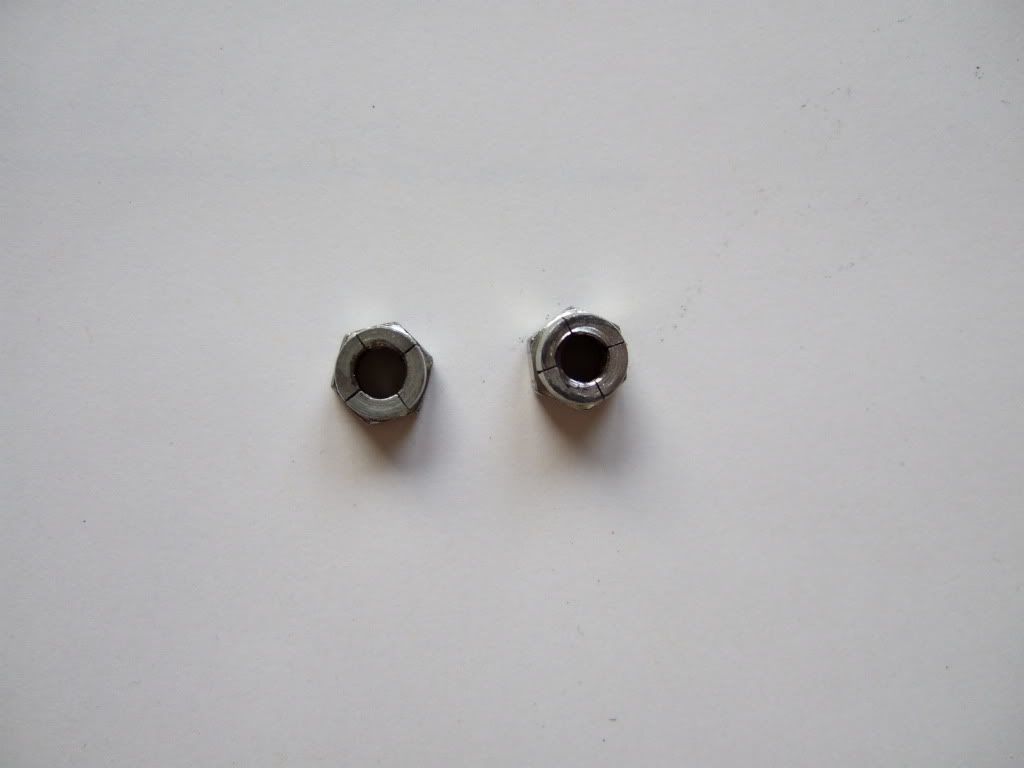
I wonder at what time Linn used this type of nuts. A plastic lined nut
turned at 0.6 Nm. My suspicion is that as these nuts have absolutely no
play on the bolt, they may have a tendency to bend the bolt when their
surface is not exactly flush with the block they make contact with. If so,
they have compromised my deck since ever.
My standard M5 nuts are set now to 0.8 Nm which is better than 0.9.
In contrast to before, a certain torque leads to well defined positions
of the nut (reproducibility). I made a small extra tool to be able to
observe this, and also to recognize when a nut starts to turn. A piece
of PostIt paper attached to the LP12 cross brace served as the
indicator. Lines have 5mm spacing. Pics are self explanatory, I guess.
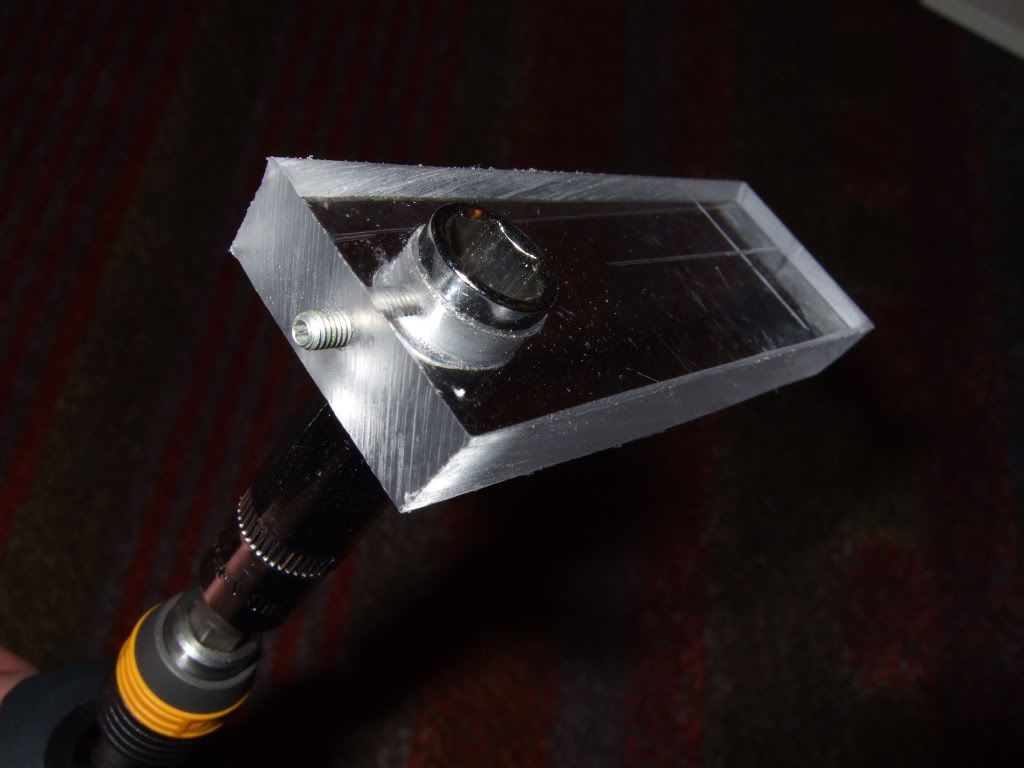
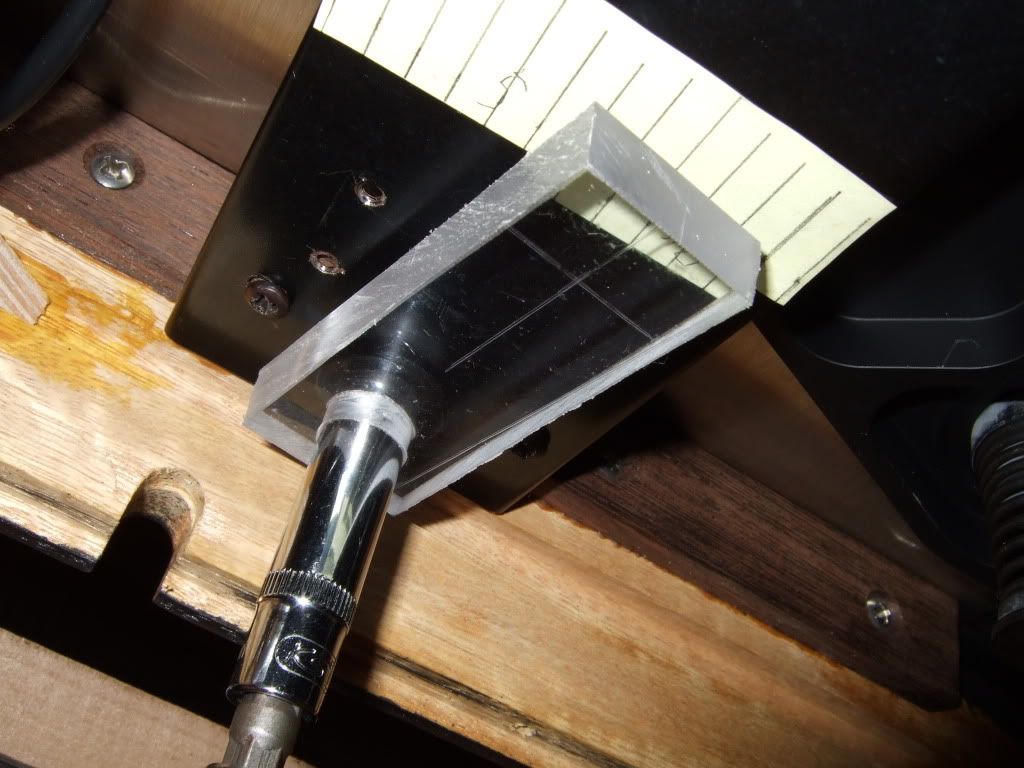
Thanks again for patience and help, regards, Klaus
Edit as of 18.12.2010: After having aligned all bolts and tightened them
to the top plate rigidly, these nuts are now at somewhat more than 1.2 Nm
due to advise from a Leicester based person. Great performance.
started to turn on a M5 bolt with 0.6, 0.9 and more than (!) 1.2 Nm:

I wonder at what time Linn used this type of nuts. A plastic lined nut
turned at 0.6 Nm. My suspicion is that as these nuts have absolutely no
play on the bolt, they may have a tendency to bend the bolt when their
surface is not exactly flush with the block they make contact with. If so,
they have compromised my deck since ever.
My standard M5 nuts are set now to 0.8 Nm which is better than 0.9.
In contrast to before, a certain torque leads to well defined positions
of the nut (reproducibility). I made a small extra tool to be able to
observe this, and also to recognize when a nut starts to turn. A piece
of PostIt paper attached to the LP12 cross brace served as the
indicator. Lines have 5mm spacing. Pics are self explanatory, I guess.


Thanks again for patience and help, regards, Klaus
Edit as of 18.12.2010: After having aligned all bolts and tightened them
to the top plate rigidly, these nuts are now at somewhat more than 1.2 Nm
due to advise from a Leicester based person. Great performance.
Last edited by k_numigl on 2010-12-18 13:47, edited 1 time in total.
Now things are starting to make sense. I definitely avoid using any of the self-locking nuts that are really tight in those two positions. The version you mention with the cross cut in them vary quite a bit in how tightly they grab the post and the very tight ones would certainly throw off the torque. You can actually loosen them by pressing the tip of a properly sized phillips screwdriver into the cross part and tighten loose ones with pliers. I only use them if they are fairly loose, otherwise I swap for a different nut. Most often I use the nuts with the plastic liner and they are loose enough to work properly.
Since we've turned this into somewhat of a torque thread I'll mention here that I have just done some experiments on the screws that hold on the hinge plates. I had originally assumed that the hinge plates wouldn't make a difference (silly me :D ) so I didn't bother testing them. But in a thread on the Linn forum Peter at Cymbiosis said that he found the LP12 sounded better with the hinge plates attached than with them removed and that they needed to be snug for best performance. This surprised me so I decided to investigate further.
I have not yet tried hinge plates on vs. off but I have tried different torques on them and did find audible differences. The changes are more subtle than most LP12 fasteners and I find the most noticeable change is in the tunefulness and pace of the bass. I have only tried this on two plinths and only on one of them did I have time to try fine increments so these should be viewed as initial findings but they are good enough to let you know about. In both cases they sounded better at .4Nm than they did loose and better at .6Nm than at .4Nm. On the second LP12 I took it farther and went up to .8Nm but felt this was worse. So I want back to .6Nm and researched values above and below there. The value I found most musical was .6Nm - 2 notches. This was after trying from +2 to -4 notches in 1 notch increments.
The plinths I tested this on were a Walnut and a Movingui plinth so it could change a bit for a different wood, although I think most woods should be close to the same. I will be interested to see what others think once they have tried it.
Since we've turned this into somewhat of a torque thread I'll mention here that I have just done some experiments on the screws that hold on the hinge plates. I had originally assumed that the hinge plates wouldn't make a difference (silly me :D ) so I didn't bother testing them. But in a thread on the Linn forum Peter at Cymbiosis said that he found the LP12 sounded better with the hinge plates attached than with them removed and that they needed to be snug for best performance. This surprised me so I decided to investigate further.
I have not yet tried hinge plates on vs. off but I have tried different torques on them and did find audible differences. The changes are more subtle than most LP12 fasteners and I find the most noticeable change is in the tunefulness and pace of the bass. I have only tried this on two plinths and only on one of them did I have time to try fine increments so these should be viewed as initial findings but they are good enough to let you know about. In both cases they sounded better at .4Nm than they did loose and better at .6Nm than at .4Nm. On the second LP12 I took it farther and went up to .8Nm but felt this was worse. So I want back to .6Nm and researched values above and below there. The value I found most musical was .6Nm - 2 notches. This was after trying from +2 to -4 notches in 1 notch increments.
The plinths I tested this on were a Walnut and a Movingui plinth so it could change a bit for a different wood, although I think most woods should be close to the same. I will be interested to see what others think once they have tried it.
Sounds right to me! That's about where I set mine.k_numigl wrote:My standard M5 nuts are set now to 0.8 Nm which is better than 0.9.
You sure attack these challenges in the most scientific way, Klaus!I made a small extra tool to be able to observe this, and also to recognize when a nut starts to turn. A piece of PostIt paper attached to the LP12 cross brace served as the indicator. Lines have 5mm spacing.
Just like Thomas, I replace nuts that are tight with loose ones. Even if anti-rotation feels right to keep the nuts from loosening, humidity changes will unfortunately alter the tension anyway. In dry weather, like winter which we now have in Scandinavia, the wood compresses and the tension drops markedly. For optimal performance, I think there are a couple of screws that should preferably be adjusted twice a year. Not all of them, just a couple.
Wood movement is a complex issue. Of course, there's shrinking in
dry environments, but there's also compression setting in humid
surroundings...... It is best to do what you can to avoid humidity cycling,
especially to avoid humidity extremes.
I'm living in a wooden house, and found humidifiers for winter
indispensible. (I know, in Scandinavia things are worse.) Resetting
some screws twice a year seems a good idea to me - not too difficult
if you know to which value.
dry environments, but there's also compression setting in humid
surroundings...... It is best to do what you can to avoid humidity cycling,
especially to avoid humidity extremes.
I'm living in a wooden house, and found humidifiers for winter
indispensible. (I know, in Scandinavia things are worse.) Resetting
some screws twice a year seems a good idea to me - not too difficult
if you know to which value.
M4 done
As nobody seemed to have an opinion immediately I waited for this
weekend to check the M4 tapping. No objections arose either, so I
simply started, as I personally found it the right way to proceed.
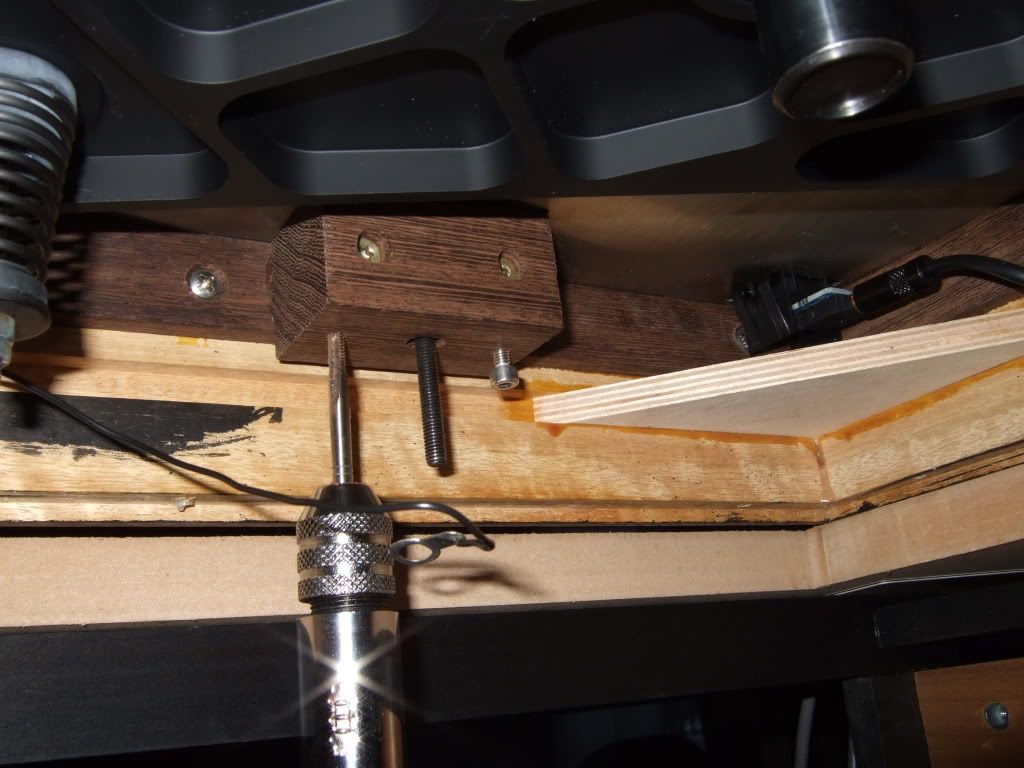
I did not take the deck completely apart, but left as much as possible in
place, to be able to compare the single modification step. Screws are
now M4 3-mm-hex-head, 10 or 12 mm long, sorry, I forgot to record.
Washer and spring washer applied, too. They are now a delight to turn
and have been torqued to 0.4 Nm. This is pretty strong, and I don't
think I was at this point with the wood screws. As the latter have a much
steeper thread angle, too, contact force is most likely much larger now.
Isuspect the more important point is a more even distribution of
contacts.
Holes in the cross brace were enlarged to 5 mm to ensure that all
screws (and the bolts) are free of sideward stresses. Holes in the wood
and in the metal parts carefully deburred.
Musically it is a marked progress. Sound similar as before, but every
tiny bit and instrument much more at its well defined place. More
and impressing subleties to listen too, while maintaining pace and
drive. That's what we want from a LP12: detail _and_ bounce. Slowly
the performance gets to levels that surprise me.
I'm not completely sure whether to attribute this to the mod of the
cross brace alone, as I also changed the position of the earth wire.
It annoyed me to have to dismount the earth wire connection point at
the bolt each time I want to change the torque there. The added mass
of tow nuts on this bolt could also be a compomise, I thought. Present
installation can be seen from the pic.
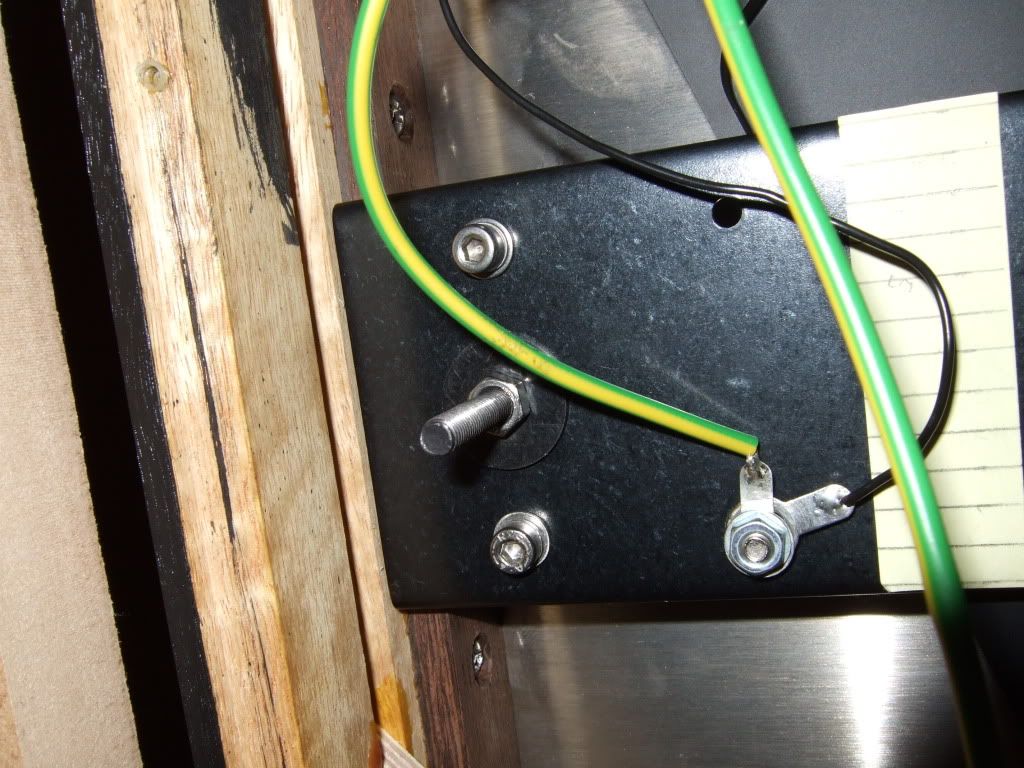
With this installation, the bolts could be shortened considerably,
reducing potential vibration at the free ends. Pros or cons seen for
this?
Regards, Klaus
weekend to check the M4 tapping. No objections arose either, so I
simply started, as I personally found it the right way to proceed.

I did not take the deck completely apart, but left as much as possible in
place, to be able to compare the single modification step. Screws are
now M4 3-mm-hex-head, 10 or 12 mm long, sorry, I forgot to record.
Washer and spring washer applied, too. They are now a delight to turn
and have been torqued to 0.4 Nm. This is pretty strong, and I don't
think I was at this point with the wood screws. As the latter have a much
steeper thread angle, too, contact force is most likely much larger now.
Isuspect the more important point is a more even distribution of
contacts.
Holes in the cross brace were enlarged to 5 mm to ensure that all
screws (and the bolts) are free of sideward stresses. Holes in the wood
and in the metal parts carefully deburred.
Musically it is a marked progress. Sound similar as before, but every
tiny bit and instrument much more at its well defined place. More
and impressing subleties to listen too, while maintaining pace and
drive. That's what we want from a LP12: detail _and_ bounce. Slowly
the performance gets to levels that surprise me.
I'm not completely sure whether to attribute this to the mod of the
cross brace alone, as I also changed the position of the earth wire.
It annoyed me to have to dismount the earth wire connection point at
the bolt each time I want to change the torque there. The added mass
of tow nuts on this bolt could also be a compomise, I thought. Present
installation can be seen from the pic.

With this installation, the bolts could be shortened considerably,
reducing potential vibration at the free ends. Pros or cons seen for
this?
Regards, Klaus
Thanks for your continued reports, Klaus.
My gut feeling is that replacing the wood screws with machine screws can only be an improvement. As you say, the steep thread angle of wood screws make them hopeless for torque tightening.
The new ground point you've created is something I'd evaluate independently if I were you. I suspect the top plate grounding to be more important that the cross brace, and your change has moved the ground point away from the top plate.
My gut feeling is that replacing the wood screws with machine screws can only be an improvement. As you say, the steep thread angle of wood screws make them hopeless for torque tightening.
The new ground point you've created is something I'd evaluate independently if I were you. I suspect the top plate grounding to be more important that the cross brace, and your change has moved the ground point away from the top plate.
Fredrik, thanks for pointing this out. Of course it is very unscientific to do
several mods at the same time, and you soon get the penalty for that.
I put the earth wires back to their position on the bolt, and yes, it makes
a difference. Good news: The cross brace mod reveals an improvement
with both positions of the earth wires. Bad news: I don't know which
to prefer.
Cross brace position: Sound is more detailed, more nuances to hear,
comparable perhaps to the difference between old tweeters and 3Ks.
There's a better definition of the place of individual instruments, and
live recordings with audiences clapping hands give a better idea of
the room (OK, that's not exactly musical flow, but just accept it as a try
to describe the situation). Musicians play very lively yet things are
not sounding nervous.
Bolt position: Changing to this gave the impression that the cross brace
position overstates the higher registers a bit. At the same time, it sounds
a bit more muddled, still nice musical flow, however, and tonal balance
presumably quite right. It's a bit less exciting, but very smooth and steady.
The essentials of the tune are present with both versions. The difference
is presumably enlarged to illustrate it.
My feeling is that both versions are slightly compromised, as we
expect outstanding definition and good tune and good tonal balance.
So both are most likely not the final solution. I have no idea,
whether the sound difference is due to electrical or to mechanical
differences. I still do have the idea to get rid of all unnecessary masses
which can vibrate, i.e. shorten the bolts as much as is reasonable. As
we don't have p-clips and boards on them any more, this is a bit.
But next step is to switch back to the cross brace position
to ensure reproducibility of the result.
several mods at the same time, and you soon get the penalty for that.
I put the earth wires back to their position on the bolt, and yes, it makes
a difference. Good news: The cross brace mod reveals an improvement
with both positions of the earth wires. Bad news: I don't know which
to prefer.
Cross brace position: Sound is more detailed, more nuances to hear,
comparable perhaps to the difference between old tweeters and 3Ks.
There's a better definition of the place of individual instruments, and
live recordings with audiences clapping hands give a better idea of
the room (OK, that's not exactly musical flow, but just accept it as a try
to describe the situation). Musicians play very lively yet things are
not sounding nervous.
Bolt position: Changing to this gave the impression that the cross brace
position overstates the higher registers a bit. At the same time, it sounds
a bit more muddled, still nice musical flow, however, and tonal balance
presumably quite right. It's a bit less exciting, but very smooth and steady.
The essentials of the tune are present with both versions. The difference
is presumably enlarged to illustrate it.
My feeling is that both versions are slightly compromised, as we
expect outstanding definition and good tune and good tonal balance.
So both are most likely not the final solution. I have no idea,
whether the sound difference is due to electrical or to mechanical
differences. I still do have the idea to get rid of all unnecessary masses
which can vibrate, i.e. shorten the bolts as much as is reasonable. As
we don't have p-clips and boards on them any more, this is a bit.
But next step is to switch back to the cross brace position
to ensure reproducibility of the result.
'scuse me for posting in such small intervals. Installing the earth wire
back to the cross brace position makes me feel the difference much
more prominent. (So perhaps having to go back and forth is not so much
of a penalty now.....) Every strand of the music makes more sense -
and fun - and all the small inflections seem to be done by the artists
much more on purpose with what seems the 'false' earth wire connection.
Regards, Klaus
back to the cross brace position makes me feel the difference much
more prominent. (So perhaps having to go back and forth is not so much
of a penalty now.....) Every strand of the music makes more sense -
and fun - and all the small inflections seem to be done by the artists
much more on purpose with what seems the 'false' earth wire connection.
Regards, Klaus
springs
A visual inspection of the LP12 springs showed that I have two very
similar springs, and one that deviates in shape:

The two outer ones have a nice and very thin end on the side that resides
on the table, the one in the middle has a much thicker end and can even
rock on this pivot point. The winding is also different:
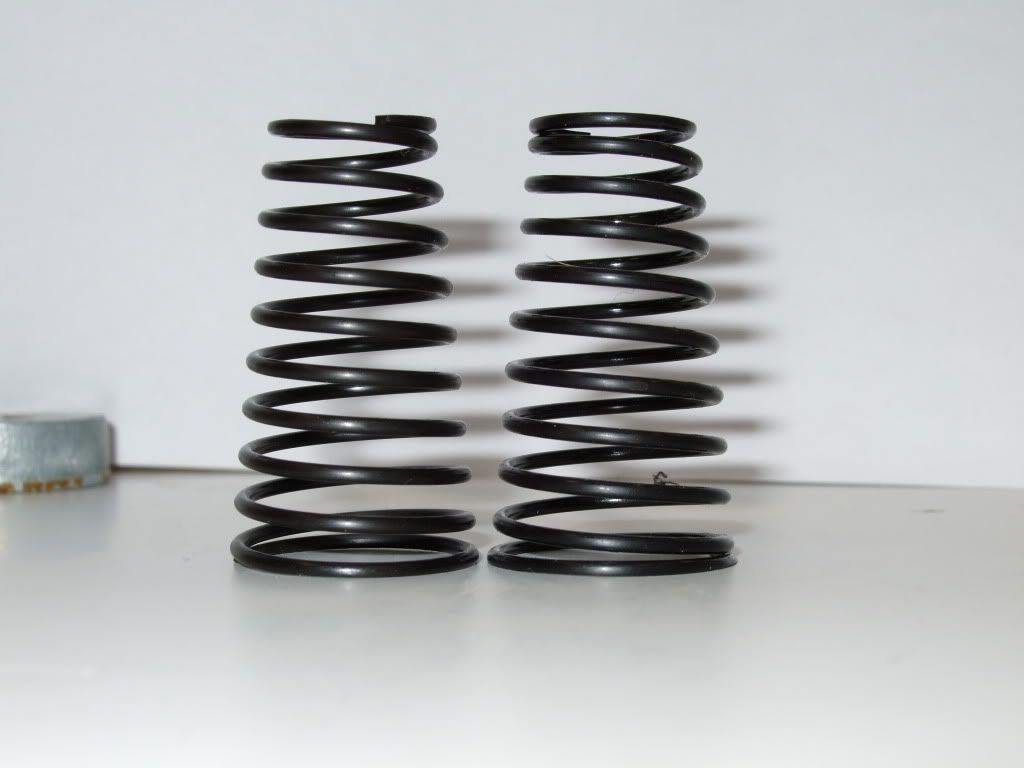
while the other two show very similar windings:
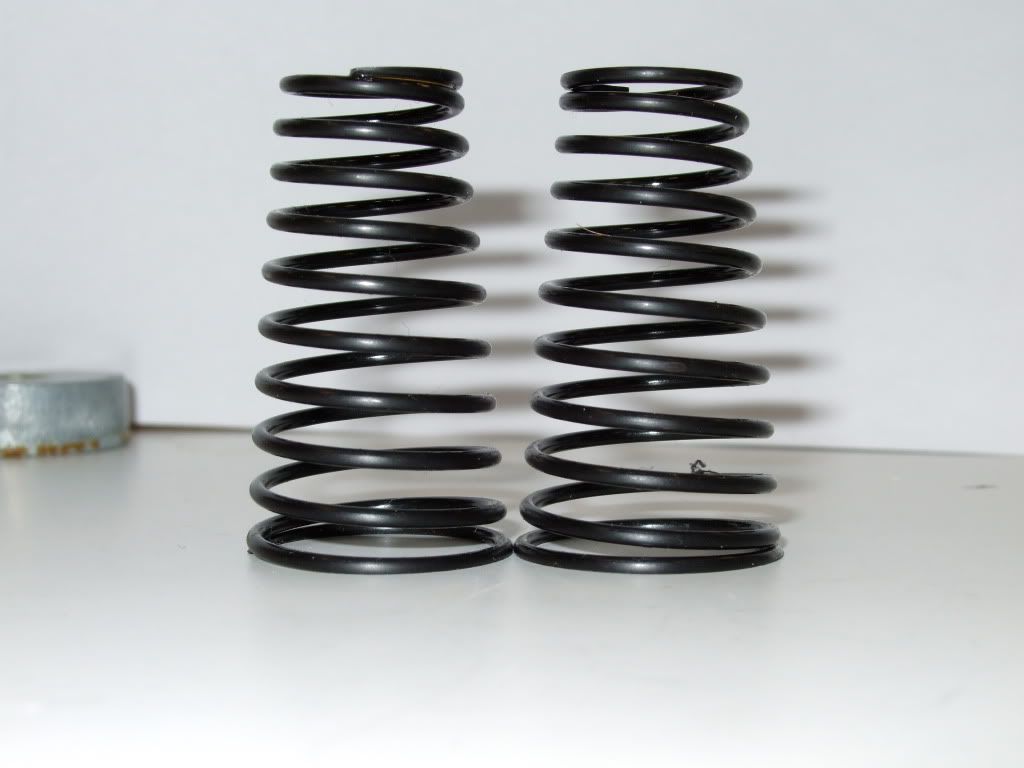
(The springs are turned 180 degrees against each other so that the
spacing between the windings can be compared more easily.) Is it
reasonable to preselect springs on the basis of such a visual appearance?
I tend to look for three similar ones and avoid the one which can
rock a bit on the flat table surface.
Regards, Klaus
similar springs, and one that deviates in shape:

The two outer ones have a nice and very thin end on the side that resides
on the table, the one in the middle has a much thicker end and can even
rock on this pivot point. The winding is also different:

while the other two show very similar windings:

(The springs are turned 180 degrees against each other so that the
spacing between the windings can be compared more easily.) Is it
reasonable to preselect springs on the basis of such a visual appearance?
I tend to look for three similar ones and avoid the one which can
rock a bit on the flat table surface.
Regards, Klaus
- Tony Tune-age
- Very active member

- Posts: 1661
- Joined: 2009-12-19 19:07
- Location: United States
Re: springs
A couple of weeks ago, my Sondek was adjusted and calibrated by ThomasOK which included installing a new Linn spring. Apparently while he was putting the parts together again, he noticed the front spring didn't bounce in the same fashion as the other two springs. However, there wasn't any physical visual difference that he noticed.k_numigl wrote:A visual inspection of the LP12 springs showed that I have two very
similar springs, and one that deviates in shape:
The two outer ones have a nice and very thin end on the side that resides
on the table, the one in the middle has a much thicker end and can even
rock on this pivot point. The winding is also different:
while the other two show very similar windings:
(The springs are turned 180 degrees against each other so that the
spacing between the windings can be compared more easily.) Is it
reasonable to preselect springs on the basis of such a visual appearance?
I tend to look for three similar ones and avoid the one which can
rock a bit on the flat table surface.
Linn has recently manufactured new springs for the Sondek, although they don't look any different. But according to Linn, they are more consistant in their performance.
Tony Tune-age
Thanks, Tony, seems to mean that you have to sort out visually first but you
are not sure the others perform consistently, nevertheless. This fits
to my (very small) experience, as there was a seemingly nice spring
at my LP12, too, which had to be replaced to get a good set up (either it
bounced nicely but rattled or it was rattlefree but not bouncing well).
In the meantime my deck conversion seems to come to a good end.
Measures taken were: Complete disassembly of the deck. Top plate
bent to rattle free (needed). Bolts tightened evenly to the top plate
(needed). Spring bolts adjusted to be exactly vertical (needed). One
of the springs exchanged (needed). New (self locking) nuts on the
spring bolts. Top plate bolts tightened more rigidly (slightly >1.2 Nm).
Foam block below tone arm plug removed (so cables move freely in air).
No wonder the deck plays in a different league by now.... (As you might
guess these wonders do not 'fall from the sky' but are due to much
appreciated advice from Peter who was my nearest 'local dealer' when
chosing between Uppsala, US and UK....)
All other adjustments are as before, i.e. cable separation, disposal of
self locking nuts on top plate bolts, M4 connection of cross brace to
blocks, earth connection moved, centered outer platter (0.05 mm feeler
gauge), vtf 1.965 g (with a smile for the last digit), &c..
There remains to test whether a shortening of the exceedingly long
top plate bolts is an improvement (what I do guess). But I have to
still find a solution how to cut them in place without taking the deck
apart so all the other adjustments are kept as they are.
As always, mods are documented by recordings and whoever may find
them interesting is invited to get them and play them on a DS.
Considering the unveiled potential of the LP12, I would find it a great
idea to have something like a LP12 set up summer school in Scotland
(perhaps 2 day course, remaining week trip to Oban &c. :-)) or
elsewhere for interested users.
Regards, Klaus
are not sure the others perform consistently, nevertheless. This fits
to my (very small) experience, as there was a seemingly nice spring
at my LP12, too, which had to be replaced to get a good set up (either it
bounced nicely but rattled or it was rattlefree but not bouncing well).
In the meantime my deck conversion seems to come to a good end.
Measures taken were: Complete disassembly of the deck. Top plate
bent to rattle free (needed). Bolts tightened evenly to the top plate
(needed). Spring bolts adjusted to be exactly vertical (needed). One
of the springs exchanged (needed). New (self locking) nuts on the
spring bolts. Top plate bolts tightened more rigidly (slightly >1.2 Nm).
Foam block below tone arm plug removed (so cables move freely in air).
No wonder the deck plays in a different league by now.... (As you might
guess these wonders do not 'fall from the sky' but are due to much
appreciated advice from Peter who was my nearest 'local dealer' when
chosing between Uppsala, US and UK....)
All other adjustments are as before, i.e. cable separation, disposal of
self locking nuts on top plate bolts, M4 connection of cross brace to
blocks, earth connection moved, centered outer platter (0.05 mm feeler
gauge), vtf 1.965 g (with a smile for the last digit), &c..
There remains to test whether a shortening of the exceedingly long
top plate bolts is an improvement (what I do guess). But I have to
still find a solution how to cut them in place without taking the deck
apart so all the other adjustments are kept as they are.
As always, mods are documented by recordings and whoever may find
them interesting is invited to get them and play them on a DS.
Considering the unveiled potential of the LP12, I would find it a great
idea to have something like a LP12 set up summer school in Scotland
(perhaps 2 day course, remaining week trip to Oban &c. :-)) or
elsewhere for interested users.
Regards, Klaus
- Tony Tune-age
- Very active member

- Posts: 1661
- Joined: 2009-12-19 19:07
- Location: United States
There is much to learn about proper set-up for the Sondek LP12 turntable. Certainly more than I realized originally...k_numigl wrote:Thanks, Tony, seems to mean that you have to sort out visually first but you are not sure the others perform consistently, nevertheless. This fits to my (very small) experience, as there was a seemingly nice spring at my LP12, too, which had to be replaced to get a good set up (either it bounced nicely but rattled or it was rattlefree but not bouncing well).
Considering the unveiled potential of the LP12, I would find it a great
idea to have something like a LP12 set up summer school in Scotland
(perhaps 2 day course, remaining week trip to Oban &c. :-)) or
elsewhere for interested users.
 Even people like ThomasOK continue to learn more about this unique piece of equipment. Fortunately, the Sondek turntable just keeps getting better and in my opinion represents one of the best values in audio :!:
Even people like ThomasOK continue to learn more about this unique piece of equipment. Fortunately, the Sondek turntable just keeps getting better and in my opinion represents one of the best values in audio :!: It would be both informative and useful to attend a Sondek class regarding the proper function and set-up 8) .
Tony Tune-age
- Tony Tune-age
- Very active member

- Posts: 1661
- Joined: 2009-12-19 19:07
- Location: United States
Yes, but the hands-on aspect is something that could be much
appreciated by those who don't handle these things on a daily basis -
I include myself in this category. It takes a while to get more or less
familiar with the constituents of the deck in practice.
Another result I'd like to share: There is another sweet spot for the
tonearm screw, lying a bit above 2.1 Nm. I received the hint from a
Linn forum contributor, was initially reluctant to try it, and at first
disappointed with my setting at exactly 2.1. Things were 'better
defined' but there was a 'digital stiffness' and less musical flow.
But keeping in mind F's advice to go up and down in tiny steps, I
used 0.1/6 Nm steps and, surprise, at 2.1 _plus_ 1 step both definiton
was there (much better than at 1.75 Nm) and musical enjoyment and
flow suddenly reappeared (on a higher level, so to say).
There really seem to be several local highs and lows along the torque
curve (with extended low regions and small peaks) - and I can't imagine
to go up the entire scale in these tiny increments. By the modification
process I conducted during the last months I got the general impression
that a more solid connection is an advantage _if_ you can find a
musical point in those higher regions. Then there is a benefit in
definiton, dynamics, liveliness, natural appearance _without_
compromises in direction to 'digital coarseness' and lesser musical
flow.
If someone tries this spot, feedback is much appreciated.
Regards, Klaus
appreciated by those who don't handle these things on a daily basis -
I include myself in this category. It takes a while to get more or less
familiar with the constituents of the deck in practice.
Another result I'd like to share: There is another sweet spot for the
tonearm screw, lying a bit above 2.1 Nm. I received the hint from a
Linn forum contributor, was initially reluctant to try it, and at first
disappointed with my setting at exactly 2.1. Things were 'better
defined' but there was a 'digital stiffness' and less musical flow.
But keeping in mind F's advice to go up and down in tiny steps, I
used 0.1/6 Nm steps and, surprise, at 2.1 _plus_ 1 step both definiton
was there (much better than at 1.75 Nm) and musical enjoyment and
flow suddenly reappeared (on a higher level, so to say).
There really seem to be several local highs and lows along the torque
curve (with extended low regions and small peaks) - and I can't imagine
to go up the entire scale in these tiny increments. By the modification
process I conducted during the last months I got the general impression
that a more solid connection is an advantage _if_ you can find a
musical point in those higher regions. Then there is a benefit in
definiton, dynamics, liveliness, natural appearance _without_
compromises in direction to 'digital coarseness' and lesser musical
flow.
If someone tries this spot, feedback is much appreciated.
Regards, Klaus
Klaus, what torques have you tightened these two ground points with? And is the thread on the fasteners comparable?k_numigl wrote:Cross brace position: Sound is more detailed, more nuances to hear...
Bolt position: Changing to this gave the impression that the cross brace
position overstates the higher registers a bit. At the same time, it sounds...
I'm asking because I am somewhat surprised that the by-Linn-developed bolt grounding is worse performing than your new position on the cross brace, and I'm trying to figure out what could cause this.
The torque with which they're tightened must be controlled, because this could affect the outcome of your comparison. If you have already taken care of this, one explanation that I'm considering is that in some circuits, a daisy chain of connection points is preferable to a parallel connection. And your cross brace position more resembles a daisy chain connection, with the ground going from tone arm, to subchassis, to crossbrace, to bolt and finally to the top plate.
Regardless of the explanation, I'd like to hear what this change of ground point does to the music. Maybe I'll find some time for it early next year.
Sorry, I must admit not to have taken care of this - I didn't regard the screws as part of the mechanical construction. I tightened them 'reasonably', I estimate to about 1.3 Nm, but there's no reliable value measured. The thread is given by DIN: M5 on the bolt, M4 on the cross brace.Lejonklou wrote: The torque with which they're tightened must be controlled, because this could affect the outcome of your comparison.
I see two obvious points which can contribute to an electrical difference. One is the path of the connections, the second the quality of the contacts. The hole in the cross brace for the new M4 screw is freshly drilled and I use a non passivated stainless screw. This might result in a better contact than the passivated bolt provides. However, with hinges torques making differences apparently, I also regard the (mechanical) mass distribution (2 nuts leaving the bolt) as a potential cause. (Why not simply add them without connectors and see what happens? I'll see if I find time.)
Regards, Klaus
correct myself
Correction: Setting of the tomearm bolt is back to 1.75 Nm. The higher
value was only seemingly a progress. The emphasis on the higher
register gave the illusion of great detail but was counterproductive
on a number of records. (That happens when hobby listeners like me do the
job - it may take them a while to recognize they went the wrong path...
while more trained persons see it immediately. I'm convinced test
listening is an art and it takes much time to learn it properly.)
It took me some effort to localize the sweetest spot at about 1.75 Nm. As
described by Fredrik and Thomas tiny adjustments matter. I modified
the torque by less than 1/6 of 0.1 Nm to find it, perhaps 1/4 or 1/3 of
this 1/6 scaling. I'd appreciate something like a Nonius on the scale.
The setting is now veeeery slightly below 1.75. Lower values getting
lamer, higher values getting stiffer. Tonarm is a pre-SE Ekos (AFAIK
Ekos I and II have only different lubrification).
I thought I should post this to prevent that too many try the
higher value :-). Test listening was much facilitated by an improved
torque setting of the 3k-array which showed to be also very sensitive.
Regards, Klaus
value was only seemingly a progress. The emphasis on the higher
register gave the illusion of great detail but was counterproductive
on a number of records. (That happens when hobby listeners like me do the
job - it may take them a while to recognize they went the wrong path...
while more trained persons see it immediately. I'm convinced test
listening is an art and it takes much time to learn it properly.)
It took me some effort to localize the sweetest spot at about 1.75 Nm. As
described by Fredrik and Thomas tiny adjustments matter. I modified
the torque by less than 1/6 of 0.1 Nm to find it, perhaps 1/4 or 1/3 of
this 1/6 scaling. I'd appreciate something like a Nonius on the scale.
The setting is now veeeery slightly below 1.75. Lower values getting
lamer, higher values getting stiffer. Tonarm is a pre-SE Ekos (AFAIK
Ekos I and II have only different lubrification).
I thought I should post this to prevent that too many try the
higher value :-). Test listening was much facilitated by an improved
torque setting of the 3k-array which showed to be also very sensitive.
Regards, Klaus
Re: correct myself
Thank you for the update, Klaus. Your findings matches mine. Please note, however, that tonearms with a slot in the pillar always seem to require a higher torque than those without a slot.
If I make one wrong decision when working on a prototype, it can set me off on an unfruitful and very time consuming track until I finally discover the original mistake. I have done that more than once, so I've become a bit obsessive with making sure I judge things right. I simply want to be 100% certain before I move on to the next step.
On the other hand, I can't spend hours evaluating one parameter when there are hundreds of similar comparisons to follow.
What has taken me a lot of time is to learn how to make accurate decisions fast.k_numigl wrote:I'm convinced test listening is an art and it takes much time to learn it properly.
If I make one wrong decision when working on a prototype, it can set me off on an unfruitful and very time consuming track until I finally discover the original mistake. I have done that more than once, so I've become a bit obsessive with making sure I judge things right. I simply want to be 100% certain before I move on to the next step.
On the other hand, I can't spend hours evaluating one parameter when there are hundreds of similar comparisons to follow.
Re: correct myself
Its much easier to evaluate someone elses system or equipment, than your own!What has taken me a lot of time is to learn how to make accurate decisions fast.
If I make one wrong decision when working on a prototype, it can set me off on an unfruitful and very time consuming track until I finally discover the original mistake. I have done that more than once, so I've become a bit obsessive with making sure I judge things right. I simply want to be 100% certain before I move on to the next step.
On the other hand, I can't spend hours evaluating one parameter when there are hundreds of similar comparisons to follow.
Re: correct myself
What do you suggest; that you make the comparisons for me or that I pretend someone else built the proto? :lol:anthony wrote:Its much easier to evaluate someone elses system or equipment, than your own!
